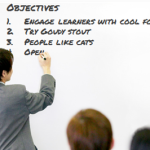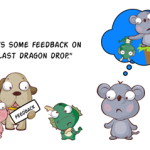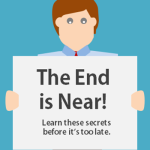[…] This post was mentioned on Twitter by Cosimo Cannata. Cosimo Cannata said: Five Ways to Guarantee Your E-Learning Course is a Success. From Articulate, http://bit.ly/dljeo0. […]
Five Ways to Guarantee Your E-Learning Course is a Success
May 11th, 2010
It would be great if elearning was just about learning and building the perfect course. Unfortunately, that’s not always the case. Much of your success hinges less on the actual course and more on the process you go through to create it. And much of that centers on the relationship you have with your customer.
In a previous post, I offered seven techniques to keep your customer happy, today I’d like to offer a few tips to help manage the expectations and relationship you have with your customers. That will help keep you happy.
Who’s the Decider?
Here’s a problem I’ve run into quite a few times. I spend three months working on a project. Right before it goes live, the proud customer invites her boss to look at the new course. The boss who was never involved in the process reviews it, offers some opinions, and wants to make changes.
Find out who has final say. And then find out what they said.
You can save a lot of heartache by finding out who will approve the final course. You want to know who signs the dotted line. If you run the risk that a “boss” is going to throw a wrench into the process, then get that boss involved when you’re still prototyping the course. Don’t wait until it’s too late or time-consuming to make changes.
Also, create an agreement that specifies deliverables and due dates. If the customer wants to make changes, then request to make changes to the agreement so that you’re not held to expectations that were created prior to additional requests.
Clarify Desired Results
There’s usually a reason that the client wants to build an elearning course. With that reason comes some desired results. Find out what those are and then build your course to meet their expectations.
I had a client once who wanted an IT security course to teach employees how to protect themselves (and the organization) while using the organization’s technology (Internet, laptops, etc.). However, when I drilled down for more information, their real issue wasn’t security. Instead, too many people were surfing the web and visiting inappropriate sites. They wanted that to stop.
In that instance, the course on IT security was not the right solution. They needed to focus on appropriate use of the organization’s resources. Unfortunately they opted for the first course and saw no significant improvement. Fortunately, they were oblivious to the futility of the elearning course and our team didn’t take the blame. But I’ve worked on similar projects that didn’t produce results because of the client’s demands and in those cases the client had no problem blaming the training group.
Get Access to All Relevant Resources
There’s a lot that goes into building a course. Make sure you get access to the right people and resources. Who can review the content? Who can provide assets like logos, images, and documentation? How will you connect with the potential learners? Who will review or pilot the course? What’s the implementation strategy? What type of IT support or technology do you need?
You need the right assets and you need the right collaborators. Make sure you have access to what you need including the subject matter experts, learners, and IT group.
If you’re to work with others on the client’s team, it’s a good idea to have them pulled into the process early. I usually ask the client to invite the person, explaining the project and expectations of how that person will support it. It helps define roles and expectations, especially when you run into roadblocks.
Set a Budget
If you’re a vendor and working for an external client, setting a budget is a given because you expect to get paid. However, if you’re building elearning courses for an internal group, budgets are rarely discussed.
It’s a good idea to ask for a small budget for additional assets like stock images or even custom development. But set that expectation up front. Tell the client you’ll need $200 and see what they say. If they say they don’t have $200, tell them you need $500. When they see prices going up, they’ll be inclined to give you $200.
In all seriousness, it doesn’t hurt to ask for some money. The worst they can say is no. It’s a lot easier to negotiate a small budget upfront than it is to come back halfway through the project requesting some money or worst case being stuck with the same old PowerPoint clip art images.
Determine How You’re Going to Measure Success
In an ideal world, all elearning courses are performance-based with very clear goals. Then you can measure performance before and after the course. However, sometimes performance isn’t the only goal. Other measures of success might include:
- Lower costs. What was the cost of training prior to elearning? Did you reduce travel costs? Are your services less expensive than alternatives? One organization I talked to was paying $15,000 per course. By doing their own production, they reduced the cost to about $3000 per course.
- Convenience. People like instant access to elearning courses and being able to take the course when it fits their schedules, especially when they’re trying to balance their workload with surfing the web.
- Satisfying service level agreements. I have my clients document expectations around key milestones and deliverables. Then I aim to beat those. At the end of the course, I solicit feedback from the customer based on the agreement. Sometimes the customer rates your performance based on imaginary agreements. By crafting a service level agreement you’re able to establish a clear understanding of expected outcomes and whether or not you met those rather than some undisclosed expectation the customer may have had.
There are other ways to measure success besides performance improvement. The key is to determine if the course has performance goals or not. If not, don’t fight trying to come up with some mystical ROI. Just find a different way to determine the value you bring to the client.
Ultimately, your success hinges on two things. The first is good communication between your client and yourself. Don’t make assumptions; clarify everything that you’re not sure about. Also don’t wait until the end to show what you’re doing. It’s a good idea to schedule regular meetings to review your progress and prototype ideas to get immediate feedback. The second success factor is action. Do the things you promised to do by the date promised. You’re client will be happy and so will you.
What are some tips that you’d offer to make elearning courses a success? Share them by clicking on the comments link.
Events
- Everyday. Check out the weekly training webinars to learn more about Rise, Storyline, and instructional design.
Free E-Learning Resources
 |
 |
 |
|
Want to learn more? Check out these articles and free resources in the community. |
Here’s a great job board for e-learning, instructional design, and training jobs |
Participate in the weekly e-learning challenges to sharpen your skills |
 |
 |
 |
|
Get your free PowerPoint templates and free graphics & stock images. |
Lots of cool e-learning examples to check out and find inspiration. |
Getting Started? This e-learning 101 series and the free e-books will help. |
22 responses to “Five Ways to Guarantee Your E-Learning Course is a Success”
Above all else, “Who’s the decider?” is probably the overall deal breaker on the front end. Whether you’re a consultant working with clients, a company hiring a third-party consultant, or even an internal company department client…ALWAYS know who holds the purse strings! It’s preventative stress!
Thanks Tom – another great and practical post. I’d add under the “get access to relavent resources” to beware of working with anything labelled “DRAFT”. I’ve worked on projects where the client seems to have everything together but the timing wasn’t right (you’ve come in too early in their process). The word “draft” on any part of the core materials equates to more revisions than your budget accounts for.
Stephanie
Hi,
I would say that the most important thing is to always have the end-user (student, trainee, or which ever word you prefer) in focus. If you forget about the end-user the result will not be successful. There is always a risk when working with SME’s that everything seems important. That might be the case when you are the expert, but for the regular user it usually isn’t. So to always question if everything the SME wants to include is important to the end-user is as I see it very important if you want to have a successful e-learning.
But maybe that’s just me ?
/Mattias Kareld
At the beginning of a project I always ask “What will success look like to you?” This way I know what the client is looking for.
Otherwise, as Tom mentioned, you run the risk of building a course that won’t help the client.
Great tips!
I love receiving your newsletters! They’re so much about valuable information and not so much about “selling something”. Thanks!
I created an “eLearning Course Creation Guidelines” document for my subject matter experts. The document lists information about deadlines, “owners” of various action items that lead up to the completed course, and an outline to help the SMEs get started with content. I very much agree with Tom’s insights this week. Holding folks accountable isn’t easy, but necessary to keep things on track, particularly where there is the chance of last-minute input.
Tom’s advice is spot on, and yet I have subcontracted with experienced learning consulting companies with 15+ years experience who still find themselves writing Change Orders when the project is ready to be deployed.
When a client is new to elearning, they may not know what they want until a few learners have completed the inaugural course.
Good listening skills and diplomacy help to build a successful relationship.
So does a clear, concise “legal” document. Good fences make good neighbors, and good contracts make good business partners.
Tom’s advice is a good start. I highly recommend the legal advice books you can find at http://www.Nolo.com
What seems to work well with some clients is to have them approve the PowerPoint slides and the script. Once both are approved, then I record the audio. This way, I get immediate feedback and can make revisions before going into production. Basically, once the script is final, then I can move forward.
LOVE your blog. I love the practical tips. I appreciate your sharing first-hand experiences and your conversational tone. Very well done!
When doing this for yourself and you are the decider; don’t get cold feet! It is very easy to get scared to pull the trigger and go live after all that work sometimes.
[…] It would be great if elearning was just about learning and building the perfect course. Unfortunately, that’s not always the case. Much of your success hinges less on the actual course and more on the process you go through to create it. And much of that centers on the relationship you have with your […] Original post […]
Thanks Tom , good advice. “the decider” is always the the right person to talk to before developing an e-learning course in order to get things right at the end of the project. thanks for your practical tips!!
Good advice Tom! I agree that communication is very critical to the success of any organiztion including when creating an e-learning environment. I have found that if the expectations are discussed before, during and after the entire process, there is less misunderstandings. My brother in law is a graphic designer and one of his biggest challenges is finding who really is the “decider”. Once that is established, the good oommunication can begin. As a person who is just getting into Instructional Design, these are good tips that I can lern from and apply when the time comes. Along with your tips, I am learning that the e-learning courses will need to have meaning and not just a means to an end.
Thanks again for sharing these good tips!
Dean
[…] Tom Werner on May 13, 2010 Solid advice from Tom Kuhlmann on contracting effectively with a client when building an e-learning […]
Excellent article, as always! However, I must point out that you omitted a key player to consider when designing an eLearning course: the audience. When I design a course, my first consideration is the audience–how much prior knowledge do they bring, how resistant are they to the content, what are their next steps upon completing the course, etc. The client/boss may sign off on the project but if it flies over the heads of the audience, you’ve wasted a lot of time.
Hi Tom,
You mentioned the importance of finding out the desired results and building a course that meets the expectations. However, because of the broad range of ability levels, I must also mention that in order for an E-Learning course to be successful we, as instructional designers, must adapt to individual learners needs. One can guarantee his/her E-Learning course is a success when he/she focuses on the needs of the learner and the organization, makes the necessary modifications and meets the needs.
[…] Five Ways to Guarantee Your E-Learning Course is a Success […]
[…] […]
Just subscribed to your newsletter. After surfing for hours all over the web for some info related to this subject, i finally found this blog.
[…] " (Learning solutions. Top articles from the eMagazine's first five years. Pfeiffer.2008). Five Ways to Guarantee Your E-Learning Course is a Success It would be great if elearning was just about learning and building the perfect course. […]
It is indeed very difficult to first choose a course and then sit through the entire process unsure of who holds the reigns to your success. Your example in “who’s the decider” is so true and I think it happens with everybody who’s anybody working painstakingly on a project only to get it altered several times, hours before the deadline. Your post presents very specific points and does not beat around the bush on what exactly the parameters are for measuring your progress.









0
comments